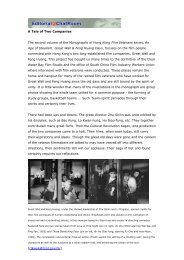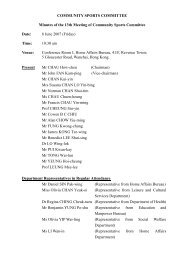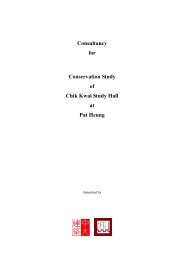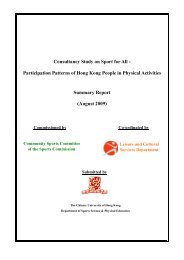Download Newsletter Issue 37
Download Newsletter Issue 37
Download Newsletter Issue 37
Create successful ePaper yourself
Turn your PDF publications into a flip-book with our unique Google optimized e-Paper software.
Editorial@ChatRoom<br />
©<br />
www.filmarchive.gov.hk<br />
Hong Kong Film Archive<br />
Head<br />
Angela Tong<br />
Section Heads<br />
Venue Mgt Rebecca Lam<br />
IT Systems Lawrence Hui<br />
Acquisition Mable Ho<br />
Conservation Edward Tse<br />
Resource Centre Chau Yu-ching<br />
Research Wong Ain-ling<br />
Editorial Kwok Ching-ling<br />
Programming Sam Ho<br />
Winnie Fu<br />
<strong>Newsletter</strong><br />
<strong>Issue</strong> <strong>37</strong> (August 2006)<br />
Editorial Kwok Ching-ling<br />
Edith Chiu<br />
50 Lei King Road,<br />
Sai Wan Ho, Hong Kong<br />
Tel: 2739 2139<br />
Fax: 2311 5229<br />
E-mail: hkfa@lcsd.gov.hk<br />
Design: TomSenga Design<br />
Printing: Friendship Printing Co., Ltd.<br />
[clkwok@lcsd.gov.hk]<br />
This summer, we happened to be tracking down the history of cinema by different routes.<br />
Filmmakers like Zhu Shilin, Yue Feng, and Bu Wancang, had already produced their masterpieces in Shanghai<br />
before they came to Hong Kong in mid-40s . Our trip to Beijing in June provided us an opportunity to appreciate<br />
these early works of them, so that we were able to grasp precisely the cinematographic connections between<br />
the two cities. These hidden gems change our impressions of their works later produced in Hong Kong. By<br />
contrasting the two stages of their artistic life, we have developed new understandings of these directors.<br />
The Beijing trip in June is just a starting point. But it has already borne fruit and will definitely lead us to<br />
explore more. Wong Ain-ling has written about the pieces of Zhu Shilin (See pp 7-9). Gosh, that is what to be<br />
meant by overstepping historical conditions! The beauty and feelings in the movie last for long and lead to<br />
endless aftertastes.<br />
Before going to Beijing, Sam Ho went over to Brazil to attend the Congress of the International Federation of<br />
Film Archives in which he gained a good deal of enlightenment (See pp 3-4) about criteria of acquisition, drawing<br />
up of standards, and executing of policies, etc.<br />
Winnie Fu fortuitously went off her track to the ‘World Cup’ (See pp 5-6). Watching some events and enjoying<br />
the excitement are vitamins for her project.<br />
Let’s set off, again and again. Let’s share gladness with people of the same taste so as to stimulate new ideas<br />
and allow our thoughts to tour around. [clkwok@lcsd.gov.hk]<br />
Acknowledgements: Ms Calmen Lui, Mr Tsang Hin-koon and Media Asia Distribution Ltd.<br />
More available in the e-<strong>Newsletter</strong>. For details of the HKFA programmes, please refer to the ProFolio and our website.<br />
Donors 5-7.2006<br />
© 2006 HKFA All rights reserved.<br />
I-Animation Limited<br />
Mr Nick Deocampo<br />
Mr Donald Hall<br />
Mr Alex Hofford<br />
Mr Andrew Tse<br />
Mr Mike Wilkins<br />
A member of the<br />
International Federation of<br />
Film Archives<br />
2
Events<br />
Film Archives<br />
in Transition<br />
Sam Ho<br />
Seeing the problems of the world made me more aware of the<br />
situation in Hong Kong. Last April, I attended the 62nd Congress of<br />
FIAF (Federación Internacional de Archivos Fílmicos), the organisation<br />
that counts as its members most of the world’s film archives. Various<br />
issues were discussed, most were informative, many inspiring, some<br />
technical, some difficult, and some inevitably boring. Together, they<br />
formed a composite of concerns with which we can relate to what we<br />
do at the Hong Kong Film Archive.<br />
The Congress started with a two-day symposium entitled ‘Film<br />
Archives in Transition’, which focused on the great changes film archives<br />
are confronted with, especially those brought on by digital technology.<br />
Members of the FIAF Technical Commission and specialists in related<br />
fields made presentations that introduced the many technical and<br />
ethical concerns of the issue, such as developing post-production<br />
modes, digital projection standards and digital preservation formats,<br />
including both image and sound.<br />
One interesting discussion was on the ethics of digital sound<br />
preservation. When modern technology is capable of erasing all kinds<br />
of technical imperfections, it is tempting to do more than what is<br />
necessary. For example, it is now possible to clean up sound tracks<br />
that were poorly recorded during the original production, like removing<br />
sound glitches so that dialogues can be more clearly heard. This may<br />
be improving on the original but it is also altering the original. The goal<br />
of preservation is to preserve, glitches and all.<br />
Another presentation provocatively confronted the imminent<br />
dangers of a digital future in which the analogue past of film is<br />
threatened. As manufacturers find it increasingly unprofitable to<br />
produce wares hard and soft for the analogue format—cameras,<br />
projectors, editing equipment etc.—they may stop production<br />
altogether. Take film stock, for example. Film archives may find<br />
themselves wanting to restore films but with no film on which to<br />
restore. It was even suggested that FIAF consider establishing operations<br />
to manufacture film stock.<br />
Another related issue is the rise in popularity of profit-oriented<br />
restoration. With DVDs of old films fast becoming a lucrative business<br />
venture, more and more films are digitally restored by film companies<br />
to meet market demands. As such, the role of film archives as primary<br />
preservers of film heritage seems less important. Or does it?<br />
The situation hits close to home in Hong Kong as we have been<br />
witnessing Shaw Brothers—and, to a lesser extent, Cathay and other<br />
smaller companies—releasing on DVD previously unavailable films.<br />
The restoration of the Shaw Brothers films, though less than<br />
satisfactory, had provided audiences and researchers alike with much<br />
treasured access to the otherwise unseen titles. The digital process,<br />
relatively inexpensive and efficient, therefore represents great<br />
opportunities despite its inherent flaw of infidelity to analogue originals<br />
and potential for shoddy restoration.<br />
It thus falls on film archives to shoulder the burdens of minimising<br />
those flaws and guarding against those potentials. As one Congress<br />
speaker urged, it is essential for film archives to maintain close dialogue<br />
with the film industry on this matter, giving our best effort to prevent<br />
and correct problems in digital restoration. It is also our responsibility<br />
to inform the public of problems when they arise and to push for better<br />
rights to protect against the problems. In Hong Kong, a strong and<br />
long-held belief in free-market enterprises may prohibit effective<br />
measures on this regard, but it only makes our work at the Film Archive<br />
all the more important.<br />
But for many film archives, such problems are a luxury they cannot<br />
afford. Attending the Congress made me acutely aware of the width<br />
in range of problems faced by the film archive community. For archives<br />
with serious budget difficulties, especially those from less developed<br />
countries, hazards of the digital process can be more of a blessing,<br />
allowing them to fulfil some functions, though greatly qualified, with<br />
affordable expenses. Their plights might not be eagerly discussed in<br />
the Congress to concentrate on deserving philosophical issues that<br />
concern the grander scheme of things, but I could only feel the schism<br />
that divides the community, a result of history and of the present,<br />
compounded by the uneven distribution of resources on a global level.<br />
In Hong Kong, our situation is somewhat in the middle of the wide<br />
spectrum of archiving concerns. We are at once blessed and cursed by<br />
timing. The Hong Kong Film Archive is run by the government, which<br />
has been channelling the resources that are the fruits of the Hong<br />
Kong people’s hard work into rescuing and preserving our film heritage,<br />
at a time when we are enjoying a prosperity unimaginable just a short<br />
while back in our history. But we had also fallen dreadfully behind,<br />
having started rather late for our mission and in the archiving<br />
movement. We have good equipment and facilities, but we are involved<br />
in a game of catching up gaspingly while also looking ahead to a future<br />
that’s not only cloudy but also the vision of which we have very little<br />
imagination and articulation, partly because of our late start.<br />
Our dilemma was powerfully illustrated by a strange happening that<br />
occurred shortly after my return from Brazil. For weeks, the whole of 3
Events<br />
Hong Kong came under the spell of one middle-aged man who threw a temper tantrum in a bus, whose antics were recorded by a fellow rider<br />
on camera phone—caught on phone, so to speak—and posted on the internet. Bus Uncle, as he quickly came to be known, triggered extensive<br />
web-dialogue and, later, media debate. Webcasts inspired by the incident followed, some of them rather creative.<br />
Is the HKFA supposed to collect these works? Webcasts are technically not films, so they may not be covered by our mandate. Yet they are<br />
moving images of our time, some of which, like those of the Bus Uncle episode, have taken on a special significance. Should our mandate then<br />
be modified to accommodate the newly emerged need? And if it is, are the government and the Hong Kong people ready to commit the<br />
required resources? Considering the vast amount of webcasts in cyberspace, what are the criteria for collection? If the HKFA won’t collect them,<br />
shouldn’t some body? And if some individual or institution comes along to take up the responsibility, in what form should the works be<br />
preserved?<br />
Back to our already established mandate, film is arguably Hong Kong’s single most important contribution to the global realm of aesthetics.<br />
But our cinema would not have come to this achievement without the unique distillations of our history. Today, as Hong Kong looks to find its<br />
place on the international stage and on the historical continuum, the HKFA is finding itself playing a significant, though admittedly small role in<br />
that search. Attending the 62nd FIAF Congress brought for me visions of that role in sharper focus.<br />
Sam Ho is Programmer of the HKFA.<br />
4
Events<br />
Sojourn Through Balls and Films<br />
Winnie Fu<br />
Design of the exhibition on Germany<br />
television history<br />
(Lady Windermere’s Fan, 1925)<br />
(Grapes of Wrath, 1940)<br />
York,1957)<br />
Candidate,1962)<br />
(A King in New<br />
(The Manchurian<br />
1894 1921<br />
(Il Cinema Ritrovato)<br />
Arlecchino<br />
Winnie Fu (right) and Dr Rainer Rother<br />
2003<br />
1906<br />
Serpentine Dances<br />
5
Events<br />
6<br />
In the name of a rather high-sounding mission to ‘trace the history of<br />
motion pictures’, I made a study trip to Europe this summer, only to<br />
find myself setting foot on the World Cup ‘Big Three’ amid the football<br />
craze. Even a far-from-avid football viewer like me could hardly free<br />
myself from the magnetic pull, and I soon joined in heartily on the fun<br />
with the fans all over the streets.<br />
The first stop of my journey was Bologna, a rather inconspicuous<br />
city off the north of Italy. I ran head-on into the Italy vs Germany<br />
match which was to kick off the day after. Cradled between age-old<br />
buildings, Piazza Maggiore was transformed into an open air screening<br />
ground with a huge projection screen in its centre. Thrilled by the rousing<br />
victory over Germany, the entire city was buzzing with swells of cheers<br />
and whistles, and the national flag fluttering in glory everywhere. The<br />
carnival atmosphere rubbed off on everyone and did not fade until<br />
two in the morning.<br />
Gee… Don’t ever think I trekked all the way to Europe for the World<br />
Cup! If anything, the football on the big screen in Piazza Maggiore was<br />
only a sidebar to the many movie gems featured in the Il Cinema<br />
Ritrovato Festival. Under the moonlit sky sat thousands of film lovers<br />
who packed the piazza to the seams, all entranced by the moving image<br />
in the midsummer night’s breeze. Among the masterpieces selected<br />
for this year’s free outdoor screenings were John Ford’s Grapes of Wrath<br />
(1940), Charlie Chaplin’s A King in New York (1957), and The<br />
Manchurian Candidate (1962) starring Frank Sinatra. The restaurants<br />
around wasted no time in moving their tables out to offer customers<br />
a better view of the films—a feast for the eyes and the stomach rolled<br />
into one, not to mention the priceless touch of romance.<br />
My journey came as a complete revelation; I was able to embrace<br />
two cultures deep-rooted in European civilisation—football and film—<br />
at once. Nothing but perfect, isn’t it?<br />
Now in its 20th year, the Il Cinema Ritrovato Festival in Bologna,<br />
organised by Cineteca Bologna, sets out to provide film historians,<br />
archivists, curators and scholars with an open platform for exchange<br />
and valuable chances to appreciate newly restored films from the world<br />
over. Cineteca Bologna was converted from an abandoned tobacco<br />
factory. Lumière 1 & 2, two cinemas each housing more than 100<br />
visitors, have been there since two years ago to show gems with<br />
restoration value. Arlecchino, a nearby old cinema which takes no more<br />
than a ten-minute walk, is dedicated to running films in wide-screen<br />
format.<br />
Since 2003, the Festival has been staging a ‘100 Years Ago’ programme<br />
to introduce some century-old classics of all origins. This year the<br />
limelight fell on works shot in 1906, and a bevy of productions from<br />
Britain, the USA, Germany, France, Italy and the Scandinavian countries<br />
were put together under delicate selection by various curators. The<br />
diverse contents and unbridled creative vigour and vibrancy reigning<br />
these early works proved to be equally striking to this day.<br />
Among what I saw, Ernst Lubitsch’s Lady Windermere’s Fan (1925),<br />
a screen adaptation of Oscar Wilde’s comedy, left me awestruck and<br />
spellbound. The fact that I managed to see this print, claimed to be the<br />
most complete version now available in the world, made my stay too<br />
good to forget. Sitting in a baroque-style theatre with live<br />
accompaniment by the Bologna Theatre Orchestra, I was bewitched<br />
by the nobleman in the 1920s black-and-white film, whose elegance<br />
and beauty were given a celestial dimension in the grandeur of the<br />
surroundings.<br />
Also of particular note was a showcase of Vittorio De Seta which<br />
comprised ten of his documentaries dated back to the 1950s, each<br />
lasting 11 minutes. An auteur documentary director, he went through<br />
lengths to imbue his work with compelling photography and<br />
humanistic qualities. Drawn into the drama emotionally, the audience<br />
soon found themselves identifying physically with the main characters<br />
through thick and thin, as the peasants and fishermen in their daily<br />
happenings.<br />
Another crowd puller was a feature on Loïe Fuller, a serpentine dancer<br />
dubbed ‘The Flower of Cinema’. Sensually wrapped in a multi-layered<br />
tulle dress with rods on the hands as extension of her arms, she danced<br />
her way across the screen oozing an aura that was entirely her own.<br />
Back in the times when toning and tinting were the order of the day,<br />
such agile bodily movements were a treasure trove of creative muses.<br />
Born in the same year, both her art and film share the same character<br />
in drawing on motion and imagery as creative forces; such coincidence<br />
brought forth renditions in the same vein produced by film companies<br />
like Gaumont, Pathé and Edison. In this year’s retrospective, we were<br />
blessed with the opportunity to witness the crossover of the two media,<br />
in such varied forms as the floral fairy dance, serpentine dance, butterfly<br />
dance and fire dance, all emerged between 1894 and 1921. A<br />
hotchpotch as it may seem, its intrinsic vivacity remained utterly<br />
engrossing.<br />
My ‘archaeological’ trip then took a twist across the border to<br />
Germany, again following the advance of the World Cup. My arrival in<br />
Berlin coincided with the long-awaited final which was to take place<br />
the next day. Among the football buffs and cops on the streets were<br />
film crews shooting for different purposes. To echo this world event,<br />
the Filmmuseum Berlin put on an exhibition titled ‘Goal! Football and<br />
Television’, and the screenings were, needless to say, football-packed!<br />
It was my great pleasure to make the acquaintance of Dr Rainer<br />
Rother, the new Artistic Director of the Filmmuseum Berlin. Following<br />
an introduction of HKFA’s collections, exhibition and research projects,<br />
we moved on to a fruitful discussion over possible collaborations in<br />
the future. Before leaving, I was taken on a tour around the storage<br />
vaults of the museum. Last but not least, I spared some time out of<br />
my hectic schedule for two other mini-exhibitions, including a<br />
permanent presentation on Germany television history and another<br />
one on animation titled ‘Stop Motion’ in the Filmmuseum Potsdam.<br />
Allow me to quote our Chief Executive: ‘The ball is round.’ Having<br />
had a whale of a time in the world of balls and films, I turned out<br />
having to drag my feet home, which was already summoning my return<br />
from the other side of the Earth! (Translated by Elbe Lau)<br />
Winnie Fu is Programmer (Cultural Exchange) of the HKFA.
Feature<br />
Changing Heart (1943)<br />
7
Feature<br />
Husbands and Wives<br />
Hidden Gems by Zhu Shilin in the 30s and 40s<br />
Wong Ain-ling<br />
8<br />
Sometime ago, Sam Ho, Kwok Ching-ling and I made a research trip<br />
to Beijing. Most of the time, we parked ourselves inside the China Film<br />
Archive, viewing films made in Shanghai in the 30s and 40s. Our most<br />
rewarding find was some of Zhu Shilin’s early oeuvre, of which many<br />
have neither been released in Hong Kong nor distributed as DVDs in<br />
China—namely, Coming Home (1934), Die for Loving (1941), Universal<br />
Love (1942, one of the episodes ‘Conjugal Love’ was written and<br />
directed by Zhu), Changing Heart (1943) and The Modern Couple<br />
(1945). With the exception of Die for Loving, all the above films share<br />
a common theme—marital relations.<br />
Both Coming Home and ‘Conjugal Love’ portray a ménage à trois<br />
between a husband and his two wives. In Coming Home, this<br />
relationship unfolds as a serious melodrama. The protagonist, who goes<br />
abroad to study, receives news of his wife’s death in a bombing raid<br />
back home. He remarries a Eurasian woman, but when the couple<br />
returns to China, he discovers that his wife is still alive. ‘Conjugal Love’<br />
is a light-hearted romantic comedy which pokes fun at the situation<br />
of a man whose wife discovers he is keeping a mistress. In the former,<br />
the second wife initially insists on her legitimate rights, but eventually<br />
realises that her husband’s child needs the birth mother. So she quietly<br />
leaves the door key behind, and boards the ship back to her home<br />
country. In the latter, the mistress also ‘comes to her senses’ and leaves,<br />
making her lover’s family ‘complete’ again. In both cases, the onus<br />
falls on the ‘unofficial’ female spouse to resolve the moral dilemma.<br />
Changing Heart also takes the form of a morality tale, but the sexual<br />
psychology explored is rare in Chinese cinema, and the protagonists’<br />
games of seduction and their emotional tension are handled with<br />
scintillating refinement. The film opens with a close up of pair after<br />
pair of well-heeled feet, followed by a full shot of a hotel’s grand<br />
entrance. An expensive car turns up and the door opens. A close up<br />
shows a dog jumping out and a pair of men’s leather brogues. The<br />
camera moves up to introduce the male protagonist, played by Liu<br />
Qiong. Though he is a socialite, he has been married for five years to a<br />
domesticated wife (played by Nancy Chan) who prefers hearth and<br />
home to the ballroom scene. Their incompatibility is accentuated by<br />
the return of the wife’s younger sister from abroad. Looks wise, she is<br />
a mirror image of her elder sister, but unlike her, she is modishly dressed,<br />
vivacious and a social butterfly. The male protagonist has fun taking<br />
her out, and when acquaintances mistake her for his wife, he is in no<br />
hurry to clear up the misunderstanding.<br />
The film is extravagantly produced, replete with gorgeous costumes<br />
and lavish sets, brushing all the filth and turmoil of wartime reality<br />
neatly under the carpet (or at least out of the frame). This makes one<br />
recall Italy’s telefono bianco (White Telephone) movies 1 —squeaky<br />
clean entertainment films made under Fascist rule. It was the year<br />
1943. Shanghai had all but succumbed to Japanese invasion. Filmmakers<br />
and scriptwriters who stayed behind in the occupied city had no<br />
recourse to make anything but innocuous, entertainment films.<br />
Zhu Shilin was crystal clear about the situation. ‘When China United<br />
Film Company Limited (Zhonglian) was founded, there were many<br />
subjects that everyone avoided like burning coals, such as politics or<br />
class…in a nutshell, everyone was cautious to tiptoe around anything<br />
vaguely hard line. As a result, filmmakers tried turning their attention<br />
to romance or family melodrama, as a solution to overcome the<br />
impasse. With our hands tied creatively, we were relieved to just pass<br />
the mark, and dared not hope to make great accomplishments,’ Zhu<br />
said in an interview. 2<br />
So within the repressed confines of the studio, Zhu Shilin conjured<br />
up an introspective erotic space, a sequestered bower of bliss that<br />
rivalled the sophistication and wit of Lubitsch, yet made subtle<br />
references to the complex sentiments of Chinese filmmakers during<br />
the Japanese invasion. Many years later, Zhu Shilin came to Hong Kong,<br />
where he wrote the screenplay for The Lonely Heart (aka The Foolish<br />
Heart, 1956, co-directed by Lo Kwan-hung and Chen Jingbo). A film<br />
about a married woman who has an affair but eventually returns to<br />
her husband’s arms, it can be read as a variation on the same theme as<br />
Changing Heart.<br />
Throughout his career at United Photoplay Service (Lianhua), Zhu<br />
Shilin was a master at utilising the interior space of traditional Chinese<br />
architecture to scrutinise the transformations and conflicts in family<br />
and other human relationships, brought about by the transition from<br />
feudal to modern society. This is reflected in works like National<br />
Customs (1935), New Times, Old Times (aka A Loving Daughter, 1936)<br />
and Ballad of the Mother (1936). However, in Changing Heart, he<br />
transformed western architectural space into the psychological inner<br />
chambers of the male and female protagonists.<br />
Zhu Shilin was also a veteran of Chinese opera. (During the Orphan<br />
Island period before Shanghai fell entirely to the Japanese, he had<br />
written two scripts for the great Beijing opera Master Zhou Xinfang—<br />
Emperors Hui and Qin and The Righteous Marshal Wen Suchen.) His<br />
filmic treatment of dramatic scenes also reflects the influence of<br />
Chinese opera. In a climactic scene in Changing Heart, the male<br />
protagonist’s wife poses as her younger sister to test his fidelity. Zhu’s<br />
treatment skilfully fuses elements of the opera stage with film art. As<br />
the male protagonist paces around the living room, he sees his ‘sisterin-law’<br />
through a window pane that separates her bedroom from the<br />
living room. First, he walks up to the window to draw her attention,<br />
then makes his way into her room. The sensual and emotional interplay<br />
that ensues is meticulously calculated, with subtly loaded dialogue<br />
paced with operatic tension. Eventually, the ‘sister-in-law’ says: ‘If you<br />
don’t think you’ll let down your daughter Lucy, your wife, me, or<br />
yourself, then I’m easy.’ Leaning on the bed, she adopts a seductive
‘Conjugal Love’ in Universal Love (1942)<br />
pose, and the camera slowly closer into her provocative face. At this<br />
decisive moment, the male protagonist replies, ‘I love your sister. I cannot<br />
let her or let myself down.’ At this point, his wife sheds tears of joy and<br />
relief. In the finale that follows closely upon this scene, the treatment<br />
has the theatrical flavour of Chinese opera, but the mise-en-scène<br />
emulates the spectacle of Hollywood musicals—the husband stands in<br />
the garden, the sister-in-law breaks into song, and the wife comes up<br />
to hug her husband.<br />
It is not clear whether Eileen Chang had ever seen Changing Heart.<br />
Nonetheless, her post-war screenplay Long Live the Wife (1947, directed<br />
by Sang Hu) has many fascinating correspondences with the film. While<br />
Zhu’s work portrays a male-oriented fantasy realm with striking and<br />
masterful brush strokes, Zhang’s screenplay illustrates the sensitive and<br />
intricate female interior landscape with fine lines and lightness of the<br />
feather quill.<br />
Zhu Shilin’s other endeavour to represent marital life is The Modern<br />
Couple, filmed in 1944. Zhonglian had by then regrouped as China<br />
United Film Holdings Company Ltd (Huaying). Shorn of any spectacle<br />
or gimmick, the film’s unadorned naturalism already has the outlines<br />
of Zhu’s characteristic unpretentious, down-to-earth style of his 50s<br />
classics, Should They Marry? (1951) and The Dividing Wall (1952). In<br />
the opening scene of The Modern Couple, the camera focuses on a<br />
hanging lamp, and moves down to a desk, the pen and ink on the desk,<br />
and then zooms in on a piece of manuscript paper with the words<br />
‘Problems with the life of Literati’. A wedding portrait hangs lopsidedly<br />
on the wall. A hand enters the frame to put it straight. The camera<br />
moves on to show the marriage certificate framed and hung next to<br />
the wedding photo. A shot of the bottom of the bed shows a cluster of<br />
adults’ and children’s shoes. The young housewife played by Lu Biyun<br />
lies asleep on the bed, huddled with three children. The husband, played<br />
by Tu Guangqi is chipping away at his manuscript—The Modern Couple.<br />
With a few clean and unhurried shots, Zhu effortlessly encapsulates<br />
the situation of the modern nuclear family. The couple blames each<br />
other, and decides to switch roles. The wife takes off her apron and<br />
takes up the pen. The husband leaves the study for the kitchen. Many<br />
comical scenes ensue. When the wife fobs off her editor with her<br />
husband’s old manuscript, her boss takes a shine to her and offers to<br />
make her a famous ‘female author’.<br />
The episode is a playful send-up of female authors like Eileen Chang,<br />
Su Qing and Pan Liudai, who were extremely popular both before and<br />
after Shanghai’s fall. Ironically, Su Qing, who shot to fame with her<br />
autobiographical novel Ten Years in Marriage, wrote a short review of<br />
The Modern Couple. 3 Though her overall evaluation of the film was<br />
quite positive, she criticised the episode about the female author as<br />
exaggerated and overdone—perhaps she had a personal axe to grind.<br />
You’re Smart in One Way, I in Another, shot in Hong Kong in 1947,<br />
also deals with marital life, but it was drained of any humour, and the<br />
ending was pessimistic to the point of hysteria. This is extremely<br />
unusual among Zhu’s works. In a letter to his daughter Zhu Ying in<br />
1952, he wrote of his despair and bitterness at being unfairly frowned<br />
upon as an appeaser after the war. 4 Perhaps the film reflected the<br />
angst and other complex emotions he felt during that early post-war<br />
period. During the late 50s, Zhu Shilin wrote and directed Mama Sings<br />
a Song (1957) and Between Husband and Wife (1958) for Feng Huang<br />
Motion Picture Co. By then, both Leftist and Rightist camps in the<br />
Hong Kong film industry have consolidated their respective stances,<br />
so Zhu is back in his element with harmless light-hearted domestic<br />
comedies, but somehow, they lack the tenderness and sympathique<br />
spirit of The Modern Couple.<br />
Like many other film artists of his generation, Zhu Shilin’s career<br />
was as turbulent as the historical times he lived through. From<br />
concession to the occupied Shanghai in the 30s and 40s, to Cold War<br />
in 50s and 60s Hong Kong, he never gave up his artistic integrity, and<br />
struggled to find his own creative space within difficult and changing<br />
environments. Moreover, he was able to maintain a relatively steady<br />
level of artistic achievement in his entire oeuvre. It is highly fortuitous<br />
that many of his works have been preserved in good condition. I look<br />
forward to sharing them with the film lovers in the near future.<br />
(Translated by Maggie Lee)<br />
Wong Ain-ling is Research Officer of the HKFA.<br />
1.<br />
Notes<br />
Zhu Shilin<br />
White Telephone movie is a type of melodramas set against the affluent<br />
lifestyle of the bourgeoisie. Its name is derived from the white telephone<br />
commonly found in these well-off families.<br />
2.<br />
‘A Dialogue Between the Chief Editor and Zhu Shilin’, Xin Yingtan (New<br />
Film Forum), <strong>Issue</strong> 6, April 1943, Shanghai.<br />
3.<br />
4.<br />
First published in Zazhi Yuekan (Miscellany Monthly), Volume 14, <strong>Issue</strong> 6,<br />
currently selected for inclusion in Mao Haiying’s Xunfang Su Qing<br />
(Interview with Su Qing), published by Shanghai Culture Publishing Ltd,<br />
2005, p 213.<br />
Zhu Feng and Zhu Yan (ed), Zhu Shilin Yu Dianying (Zhu Shilin and His<br />
Films), Hong Kong: Cosmos Books, 1999, p 46.<br />
9
Film Conservation Jargons 12<br />
Colour Grading<br />
Edward Tse<br />
It is a common belief that the photographer assumes the ultimate<br />
control over all the parameters of his photographic work. In the<br />
phototaking process, no matter how optimal the camera settings are<br />
during exposure of the negative, still the image quality depends heavily<br />
on the development and printing process in the film laboratory—the<br />
darkroom technician would exercise his judgement upon printing the<br />
image, almost always in the photographer’s absence! It is therefore no<br />
exaggeration that the film processing and printing laboratory or the<br />
darkroom determines the final look of the print. To put it further, some<br />
maintain that even the phototaking conditions may be flawed, the<br />
image can still be ‘made good’ by darkroom techniques. Examples<br />
include push and pull processing for under and over exposed images<br />
and filtration adjustment for correcting the wrongly used film type in<br />
different colour temperature situations. They may be true in still<br />
photography but it is very different in motion picture film printing.<br />
Colour grading of motion picture film refers to the adjustment to<br />
the final appearance of the image by controlling the amount of the<br />
three basic components of light 1 used in the printing of projection<br />
copy from negative film. It affects the colour balance and light level of<br />
each scene. In traditional still photography, the colour balance and<br />
light level can be adjusted by controlling the timing of exposure instead<br />
of direct manipulation of light intensities of the three primaries. Grading<br />
is therefore also called ‘timing’ in the US. However, since the timing<br />
for each frame of image is hardly alterable in motion picture film<br />
printing 2 , the intensities can only be modified by adding or removing<br />
filters of different stopping power against each primary colour. Even<br />
though grading shares the same origin as still photography, its intrinsic<br />
restrictions on film exposure render motion picture film production<br />
rather different and far more complicated. Very often grading is carried<br />
out in collaboration with the director of photography (DoP) 3 and a<br />
highly specialised technician from the film laboratory, the film grader<br />
(or ‘timer’ in US terminology).<br />
Usually the rush printed from the camera negative for checking the<br />
scene content by the DoP is not graded, and only an optimised light<br />
level is used to allow a crude view of the film. Likewise, the working<br />
print made by assembling different clips in the editing process is neither<br />
graded. It is only during the final stage of making an answer print for<br />
the cinematographer or DoP to approve that a film grader is employed<br />
to give the film a final touch. Of course, the production team can still<br />
ask the laboratory to fine-tune the grading and printer points for the<br />
most desirable tonal appearance. Subject to the green light from the<br />
DoP, the film is then set for release. If the film is to be restored one<br />
day, the ‘release’ look of the film, which contains the colour information,<br />
should be taken as the original creative intention of the filmmaker.<br />
After the grading procedure, the optimal grading information of each<br />
scene is retained in the final release print. Such information, precisely<br />
documented in the form of paper tape, can be input into the film<br />
printer to make more release prints in the future. The film laboratory<br />
may sometimes pass the paper tape to the film owner together with<br />
the final print. Nevertheless, the film laboratory is most likely the only<br />
party keeping all the grading information as few owners are interested<br />
in technical details. Later when more prints are required, the owner<br />
simply places a request with the laboratory which would fine-tune<br />
the grading information in hand to cater for slight changes in colour<br />
of the negative, prone to arise even under very good storage conditions.<br />
Needless to say, if the negative is stored under suboptimal conditions,<br />
the whole set of negative may require complete re-grading to tally<br />
with the look of the previous release prints. However, there are cases<br />
where the shift in colour goes beyond the capability of grading<br />
techniques. The resultant print can only imitate as far as possible the<br />
original look with all sorts of compromises like undesirable contrast<br />
increase and loss of colour balance. Therefore, to prevent any loss of<br />
colour information which can be permanent, it is extremely important<br />
to preserve the colour materials when the film is first released. Although<br />
the dark stability of negative materials is generally considered higher<br />
than that of print materials, the negatives should be stored with<br />
extreme care. Furthermore, the preservation of colour material should<br />
comprise not only physical film materials but also the grading<br />
information in paper tape or other formats. Only with all these done<br />
should the preservation be considered complete.<br />
The introduction of digital cinema, an upcoming trend in the industry,<br />
has revolutionised all components of traditional post-production<br />
workflow including colour grading. Nowadays, most film productions<br />
involve the transfer of camera negative to digital intermediate for<br />
easy handling and editing in the digital post-production stage. Like<br />
the traditional workflow, the digital intermediate can also be graded<br />
scene by scene to bring about a desirable tonal appearance of the<br />
film, where adjustment on colour balance can be made with choices<br />
not available in traditional film grading process. Furthermore, it is far<br />
easier to experiment with different options than in the photochemical<br />
paradigm. The DoP can immediately see the effect without going<br />
through the printing process, nor bearing the risk of inherent<br />
discrepancies between the view in the monitor of electronic film<br />
grading machine and the final image in the release format.<br />
Nevertheless, the difference in colour space between film and digital<br />
intermediate poses another dimension of difficulties in colour<br />
reproduction. In spite of this, their merits and performance would<br />
eventually be judged by their ability to mimic the visual experience of<br />
the viewer—the ordinary human perception of the natural<br />
environment.<br />
In terms of film restoration, grading techniques are employed to<br />
reverse the effect of unacceptable shift in colour of the picture negative<br />
during reprinting of the film. If the previous grading information is<br />
available, it would take less effort to follow through each scene before<br />
fine adjustment is made. Yet very often the original grading information<br />
is found missing; the film conservator has to work closely with the<br />
film grader in hopes of combining the strengths of both so as to strike<br />
14
A typical colour grading paper tape<br />
a balance in colour grading. It is utterly crucial for the conservator<br />
to make thorough reference to all existing documentary<br />
evidences 4 of the original look of the film before making any<br />
grading decision.<br />
Edward Tse is Assistant Curator I (Conservation) of the HKFA.<br />
1<br />
Notes<br />
The three basic components of light are derived from the illusion of<br />
our visual system that all colours can be reproduced by different<br />
combinations of the three primary colours, namely, red, green and<br />
blue. However, in the film grading, the ‘filter amount’ is specified<br />
instead, for instance, in cyan, magenta and yellow.<br />
2<br />
The timing (or duration) for exposure of each frame is fixed and<br />
determined by the running speed of the film through the film printer,<br />
though the timing is not standardised at all. With a brighter light source,<br />
it is possible to accelerate the film printing process even further to an<br />
ultra-high speed.<br />
3<br />
Sometimes the final colour balance and appearance of the final image<br />
in a film can be strongly influenced by the producer, the director or<br />
the cinematographer.<br />
4<br />
Documentary evidences can be images of film stills, posters, record of<br />
the DoP or cinematographer’s comments, printing instructions for<br />
laboratories, film critiques, etc. They are collectively known as filmrelated<br />
materials in HKFA’s collection.<br />
15
Resource Centre<br />
Renovation of Resource Centre<br />
To facilitate film appreciation by school groups and members of the public,<br />
the Resource Centre will undergo a renovation project to enhance its facilities.<br />
Renovation will proceed in two phases:<br />
Phase One: 20 September – 11 October 2006<br />
(The entire Centre will be closed.)<br />
Phase Two: 12 October – 21 November 2006<br />
(The Centre will be opened to public access except for the<br />
audiovisual area.)<br />
For enquiries, please email us at hkfarc@lcsd.gov.hk<br />
16 © 2006 HKFA Not for Sale
Hong Kong Film Archive<br />
Quarterly<br />
Film archives in transition<br />
<strong>37</strong><br />
<strong>Newsletter</strong><br />
08.2006<br />
Sojourn through balls and films<br />
Hidden gems by Zhu Shilin in the 30s and 40s<br />
From film processing to post-production<br />
17











